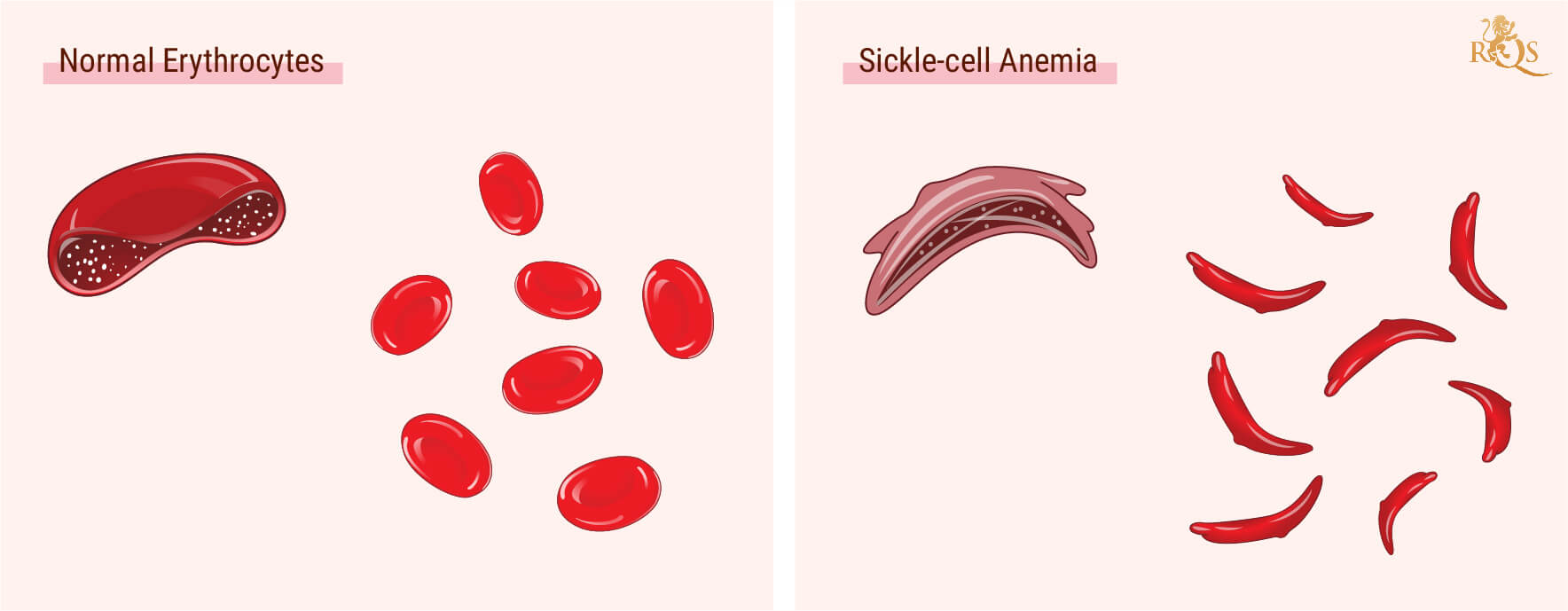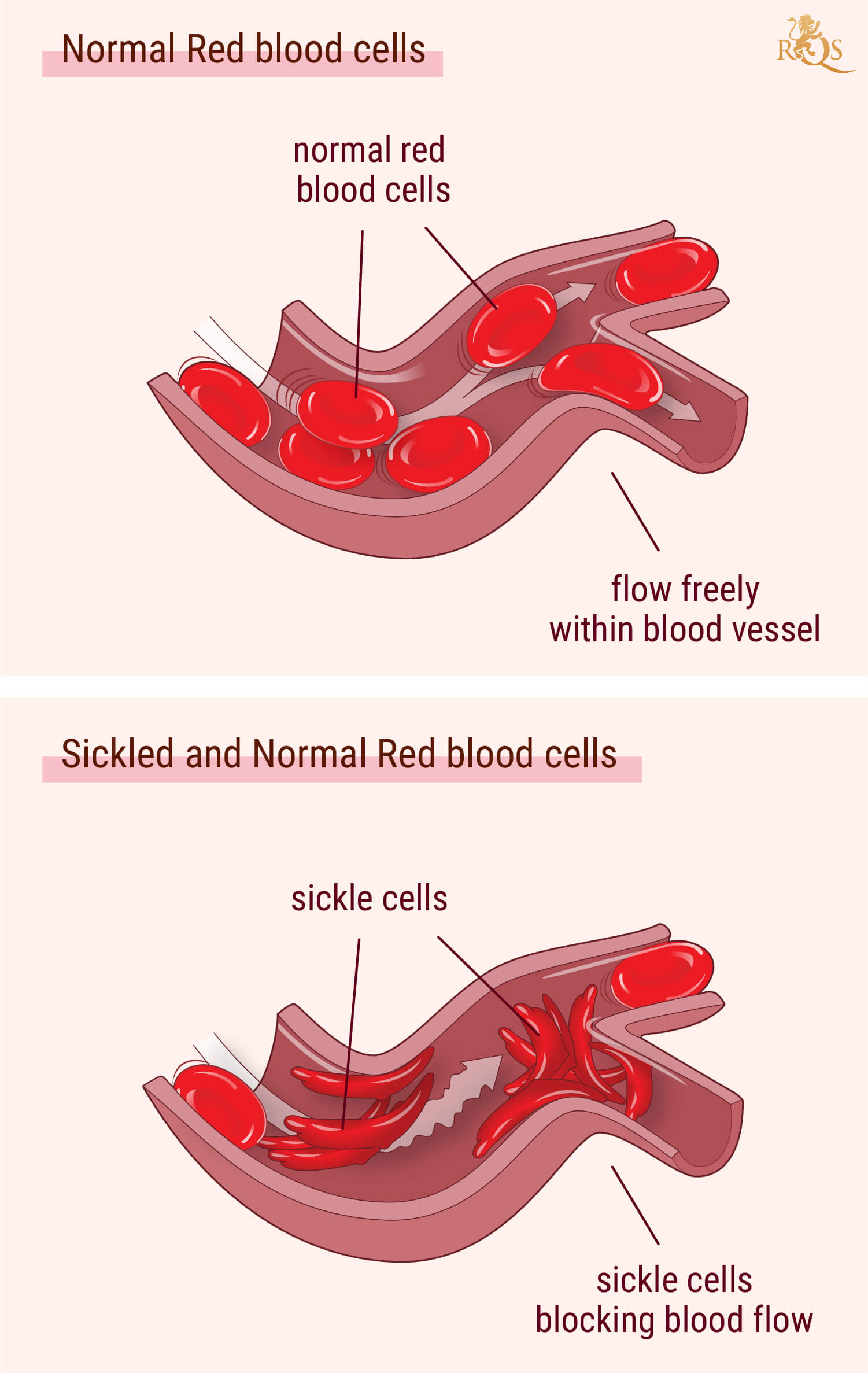.

Sickle Cell Anemia: Can Cannabis Improve Symptoms?
Sickle cell anemia causes a defect in haemoglobin, the protein that allows red blood cells to carry oxygen. In turn, red blood cells loose their shape and clog blood vessels, causing pain, swelling, and a range of serious complications. Some users report benefits from using cannabis, but can the herb really help to manage the symptoms?
Contents:
Medical cannabis research continues to ramp up. It was only a couple decades ago that most of the world viewed cannabis as a menacing drug. Not only has legalization allowed millions of people to access the plant for a growing list of conditions, but increasing acceptance means scientists are able to explore cannabis and its constituents in finer detail.
At present, researchers are in the early stages of examining the potential of cannabis for a challenging condition—sickle cell anemia. Resulting in swelling, pain, and frequent infections, can the symptoms be tamed by cannabis? Find out below.
What Is Sickle Cell Anemia?
Sickle cell anemia belongs to a larger group of disorders under the category of sickle cell disease. While some diseases have environmental causes, sickle cell anemia stems from a genetic mutation in the gene that codes for haemoglobin.
Chances are you remember the word “haemoglobin” from biology class. This iron-containing protein occurs in red blood cells and gives them their distinctive red appearance. These cells are vital for human survival, and tasked with carrying oxygen to the rest of the body and cycling carbon dioxide back to the lungs.
Haemoglobin molecules serve as the binding sites on red blood cells that allow them to carry oxygen. In cases of sickle cell anemia, a genetic fault causes a defect in haemoglobin, which in turn causes red blood cells to their change shape into that of a crescent or “sickle”. This unusual shape can produce a host of complications and symptoms.
How Sickle Cell Anemia Occurs
Sickle cell anemia occurs when two parents with sickle cell trait (SCT) pass down the genetic mutation to their children. Sickle cell trait differs from sickle cell anemia in that people with the condition have a mixture of normal and faulty haemoglobin, which prevents their cells from changing into a “sickle” shape. However, when two parents with this trait have children, there’s a 25% chance that their offspring will develop sickle cell anemia.
Most people begin to show the first signs of the disease at around 4 months of age. As well as causing red blood cells to change shape, the condition also causes them to harden. Both of these factors can cause clogging in blood vessels, which also means they get trapped in the spleen where they are disposed of. From here, red blood cell production eventually drops, causing the symptoms of anemia.


Symptoms of Sickle Cell Anemia
Sickle cell anemia causes a range of symptoms, including:
| Anemia | A hallmark of the condition, anemia is caused by a reduced number of red blood cells, leading to a lack of oxygen. This can give rise to low body temperature, tiredness, and weakness. |
| Pain | Periods of pain, known as “pain crises”, are a central symptom of the condition. The unusual shape of the cells causes them to clog blood vessels that run through the chest, joints, and abdomen. This can cause severe chronic pain requiring hospital stays. |
| Stress and low mood | The pain, tiredness, and weakness can take a toll on a patient’s mental health over time. This often manifests as low mood and high levels of stress. |
| Swelling | Clogged blood vessels and impaired blood flow also result in swelling of the hands and feet. |
| Anemia | A hallmark of the condition, anemia is caused by a reduced number of red blood cells, leading to a lack of oxygen. This can give rise to low body temperature, tiredness, and weakness. |
| Pain | Periods of pain, known as “pain crises”, are a central symptom of the condition. The unusual shape of the cells causes them to clog blood vessels that run through the chest, joints, and abdomen. This can cause severe chronic pain requiring hospital stays. |
| Stress and low mood | The pain, tiredness, and weakness can take a toll on a patient’s mental health over time. This often manifests as low mood and high levels of stress. |
| Swelling | Clogged blood vessels and impaired blood flow also result in swelling of the hands and feet. |
As well as causing these unpleasant symptoms, sickle cell anemia can lead to a host of serious complications, including:
| Organ damage | Stroke | Pulmonary hypertension |
| Leg ulcers | Pregnancy complications | Blindness |
| Organ damage | Stroke |
| Pulmonary hypertension | Leg ulcers |
| Pregnancy complications | Blindness |
Cannabis and Sickle Cell Anemia Symptoms
The symptoms of sickle cell anemia can have a big impact on the quality of patients' lives. Thankfully, several treatments are available to help keep symptoms under control. These include drugs such as L-glutamine and hydroxyurea to reduce the intensity of pain crises.
Researchers are also exploring other options to curb the severity of symptoms, including cannabis. The herb has a history of use in clinical settings, and doctors in parts of the United States and elsewhere currently prescribe it for numerous conditions.
Cannabis primarily targets a regulatory system in the body called the endocannabinoid system (ECS). This network comprises receptor sites located throughout the body, as well as signalling molecules and enzymes.
Upon ingestion, cannabinoids from cannabis interface with this system, and in doing so have a large impact on biological balance in the body—a state known as homeostasis. But cannabis contains more than just cannabinoids. The flowers also produce terpenes and flavonoids, which researchers are also exploring. Some of these compounds even appear to synergise with cannabinoids to produce more effective outcomes.
So, what does all this have to do with cannabis for sickle cell anemia? Below, we examine the relationship between cannabis and common sickle cell symptoms.


Cannabis and Mood
Millions of people use cannabis to experience euphoria. The cannabis high, triggered by the psychotropic cannabinoid THC, causes brain cells to start pumping out more dopamine. This happy hormone helps to elevate the mood in the short term, and therefore might help sickle cell anemia patients temporarily overcome low mood.
However, long-term use of THC may actually blunt the rewarding effects of cannabis[1] and cause patients to feel demotivated. Plus, not everyone responds to THC in the same way. While the molecule increases mood in some, it gives rise to anxiety and panic in others.
However, not all molecules in cannabis are highly psychotropic. The cannabinoid CBD imparts a clear-headed, even blissful effect—without a high. Boasting unique mechanisms of action, CBD binds to serotonin receptors[2] and increases levels of the “bliss molecule”[3] anandamide, possibly helping to increase mood in a more subtle, but potentially more meaningful, manner.
Cannabis and Pain
Ongoing studies are exploring the effects of cannabis on pain. ECS components occupy pain pathways in the body, and many anecdotal reports speak on the soothing relief offered by certain cannabis constituents.
In fact, a study published in the journal Cannabis and Cannabinoid Research surveyed 58 adult sickle cell disease patients, 42% of which had used cannabis in the past two years. Many of this population endorsed the herb for purposes[4] related to pain, mood, and sleep. Many also reported that using cannabis enabled them to reduce their intake of pain medication.
One of the most significant pieces of preclinical research comes from a study[5] entitled "Pain-related behaviors and neurochemical alterations in mice expressing sickle hemoglobin: modulation by cannabinoids". Using a mouse model of sickle cell disease, researchers sought to determine if cannabinoids could attenuate pain-related behaviours. Ultimately, their findings set the stage for more in-depth research into cannabis' potential pain-relieving effects in humans with sickle cell disease.


Cannabis and the Immune System
Sickle cell anemia can leave patients exposed to an increased risk of infections due to damage caused to the spleen. Research shows that the ECS plays an important role in immunity[6], and receptors occur on a variety of immune cells. Future clinical trials are needed to uncover how cannabis components might improve immunity in sickle cell anemia patients specifically.
THC vs CBD for Sickle Cell Anemia
Not enough research exists to endorse THC over CBD, or vice versa, for sickle cell anemia. And indeed, a combination of the two may be more beneficial. Because, though the distinct effects of each molecule could offer benefits to mood or physical discomfort, a combination of THC and CBD may provide more comprehensive and balanced effects.
This is supported by the creation of cannabinoid pharmaceuticals like Sativex—an oromucosal spray approved by certain medical bodies to treat spasticity caused my multiple sclerosis—which contains a 1:1 ratio of THC and CBD.
How To Take Cannabis for Sickle Cell Anemia
There are a variety of ways to consume cannabis. No studies have compared each method in humans with sickle cell anemia, but if you’re curious, we aim to locate some distinctions below.
Vaping Cannabis
Vaping uses relatively low heat to evaporate cannabinoids and terpenes, therefore avoiding combustion. This route offers a rapid onset of effects, as components quickly diffuse through the alveoli of the lungs into the bloodstream, and most people find the vaping experience rather enjoyable.
Currently, research is exploring the role of vaping cannabis[7] for pain and mood in sickle cell anemia patients, so we will soon be able to pinpoint if inhaling vapor is beneficial over other consumption methods.
Smoking Cannabis
Many recreational cannabis users prefer to smoke, despite the increased negative health consequences. Combustion exposes the lungs to high levels of carcinogens and toxins. While this in itself might prove damaging to one’s health, some sickle cell anemia patients have reported benefits[8] of using cannabis in this way.
Other Cannabis Consumption Methods
There have yet to be any studies on consumption methods other than smoking or vaping in sickle cell anemia patients. As such, we can only wonder how oral, sublingual, and transdermal intake (edibles, concentrates, skin patches and gels, etc.) might increase, decrease, or have no effect on cannabis’ impact on sickle cell anemia.


Cannabis: A Natural Approach to Sickle Disease Symptoms?
Overall, the research on cannabis and sickle cell anemia remains preliminary. That said, as avenues for comprehensive clinical research continue to open up, studies will analyze the effects of cannabis and its myriad constituents against the symptoms of sickle cell anemia with greater acuity. Hopefully, patients will soon be able to obtain clinically significant information on how to use cannabis to help their symptoms, or at the very least, not make them any worse.
- The effects of Δ9-tetrahydrocannabinol on the dopamine system https://www.ncbi.nlm.nih.gov
- Agonistic properties of cannabidiol at 5-HT1a receptors - PubMed https://pubmed.ncbi.nlm.nih.gov
- Cannabidiol enhances anandamide signaling and alleviates psychotic symptoms of schizophrenia https://www.ncbi.nlm.nih.gov
- Marijuana Use in Adults Living with Sickle Cell Disease https://www.ncbi.nlm.nih.gov
- Pain-related behaviors and neurochemical alterations in mice expressing sickle hemoglobin: modulation by cannabinoids - PubMed https://pubmed.ncbi.nlm.nih.gov
- Endocannabinoid system acts as a regulator of immune homeostasis in the gut | PNAS https://www.pnas.org
- Effect of Inhaled Cannabis for Pain in Adults With Sickle Cell Disease: A Randomized Clinical Trial | Hematology | JAMA Network Open | JAMA Network https://jamanetwork.com
- Cannabis use in sickle cell disease: a questionnaire study - PubMed https://pubmed.ncbi.nlm.nih.gov








































